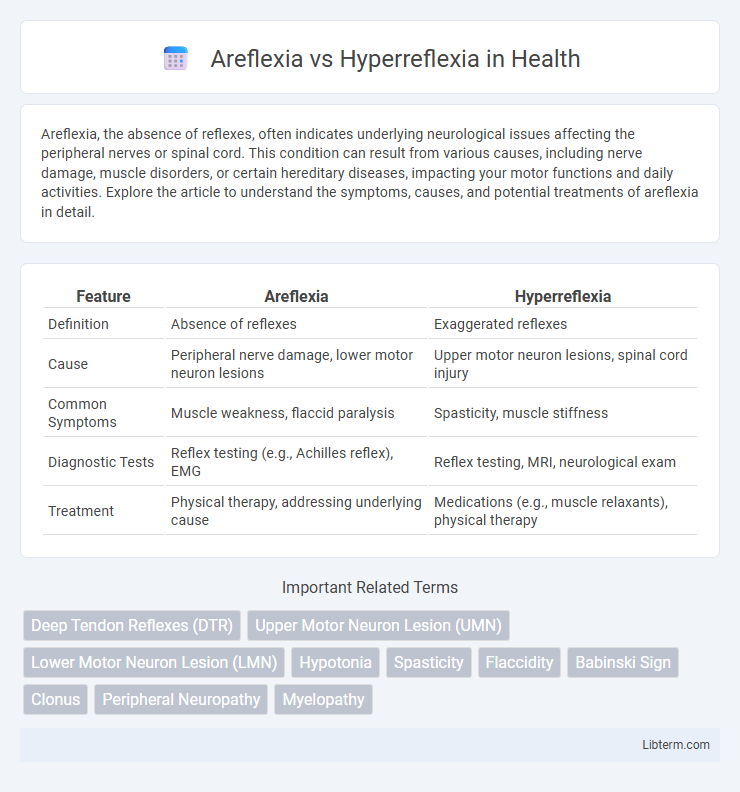Areflexia, the absence of reflexes, often indicates underlying neurological issues affecting the peripheral nerves or spinal cord. This condition can result from various causes, including nerve damage, muscle disorders, or certain hereditary diseases, impacting your motor functions and daily activities. Explore the article to understand the symptoms, causes, and potential treatments of areflexia in detail.
Table of Comparison
| Feature | Areflexia | Hyperreflexia |
|---|---|---|
| Definition | Absence of reflexes | Exaggerated reflexes |
| Cause | Peripheral nerve damage, lower motor neuron lesions | Upper motor neuron lesions, spinal cord injury |
| Common Symptoms | Muscle weakness, flaccid paralysis | Spasticity, muscle stiffness |
| Diagnostic Tests | Reflex testing (e.g., Achilles reflex), EMG | Reflex testing, MRI, neurological exam |
| Treatment | Physical therapy, addressing underlying cause | Medications (e.g., muscle relaxants), physical therapy |
Introduction to Reflexes
Reflexes are automatic, involuntary responses to stimuli that involve neural pathways controlling muscle contractions. Areflexia refers to the absence or diminished presence of these reflex responses, often indicating peripheral nerve damage or lower motor neuron lesions. Hyperreflexia involves exaggerated reflexes, typically associated with upper motor neuron lesions and central nervous system disorders affecting inhibitory pathways.
Defining Areflexia
Areflexia refers to the absence of reflexes, indicating a disruption in the neural pathways responsible for reflex arc function, often associated with peripheral nerve damage or spinal cord injury. It contrasts with hyperreflexia, which involves exaggerated reflex responses typically due to upper motor neuron lesions. Accurate differentiation between areflexia and hyperreflexia aids in diagnosing neurological disorders such as Guillain-Barre syndrome, multiple sclerosis, or stroke.
Defining Hyperreflexia
Hyperreflexia is characterized by overactive or overresponsive reflexes often caused by upper motor neuron lesions or neurological disorders such as stroke or multiple sclerosis. It contrasts with areflexia, which is the absence of reflexes typically resulting from lower motor neuron damage or peripheral neuropathy. Accurate diagnosis of hyperreflexia involves clinical assessments including deep tendon reflex testing to evaluate the degree of reflex activity.
Key Differences Between Areflexia and Hyperreflexia
Areflexia refers to the absence of reflexes, typically caused by peripheral nerve damage or lower motor neuron lesions, while hyperreflexia indicates exaggerated reflex responses often linked to upper motor neuron lesions or central nervous system disorders. The key difference lies in reflex activity: areflexia shows diminished or absent responses, whereas hyperreflexia exhibits heightened, overactive reflexes. Clinical conditions like Guillain-Barre syndrome commonly manifest areflexia, whereas spinal cord injuries frequently result in hyperreflexia.
Causes of Areflexia
Areflexia, characterized by the absence of reflexes, often results from peripheral nerve damage, neuropathies such as Guillain-Barre syndrome, or spinal cord injuries affecting the lower motor neurons. Conditions like diabetic neuropathy and certain neurodegenerative diseases impair the reflex arc, leading to diminished or absent reflex responses. Understanding these causes is crucial for differentiating areflexia from hyperreflexia, where reflexes are exaggerated due to upper motor neuron lesions.
Causes of Hyperreflexia
Hyperreflexia commonly results from upper motor neuron lesions, including spinal cord injury, stroke, multiple sclerosis, and brain trauma, which disrupt inhibitory signals to the reflex arcs. Other causes include electrolyte imbalances, certain medications such as selective serotonin reuptake inhibitors, and conditions like tetanus that lead to increased neuromuscular excitability. Unlike areflexia, caused by peripheral nerve damage or lower motor neuron lesions, hyperreflexia signifies central nervous system dysfunction with exaggerated reflex responses.
Clinical Symptoms and Presentations
Areflexia presents clinically with the absence of reflexes, often indicating lower motor neuron lesions such as peripheral neuropathy or spinal cord injury. Hyperreflexia is characterized by exaggerated reflex responses, commonly associated with upper motor neuron damage, including conditions like stroke or multiple sclerosis. Distinguishing these reflex abnormalities aids in localizing neurological deficits and guiding appropriate diagnostic evaluation.
Diagnostic Approaches
Diagnostic approaches for areflexia focus on clinical examination revealing absent reflexes often linked to peripheral neuropathy or lower motor neuron lesions. Hyperreflexia diagnosis involves neurological assessments detecting exaggerated reflexes, commonly associated with upper motor neuron damage or spinal cord injury. Electromyography (EMG) and nerve conduction studies complement reflex testing to differentiate underlying neuropathic or myopathic conditions.
Treatment Strategies for Reflex Abnormalities
Treatment strategies for areflexia primarily involve physical therapy to maintain muscle strength and prevent atrophy, alongside addressing underlying causes such as peripheral neuropathy or spinal cord injuries with medications or surgical interventions. In contrast, hyperreflexia management often includes muscle relaxants like baclofen or tizanidine, and in severe cases, intrathecal baclofen pumps or botulinum toxin injections to reduce exaggerated reflex responses. Both conditions benefit from tailored rehabilitation programs targeting neurological function restoration and symptom alleviation.
Prognosis and Patient Outcomes
Areflexia often indicates peripheral nerve or lower motor neuron damage, generally suggesting a poorer prognosis due to potential irreversible nerve injury and muscle atrophy. Hyperreflexia typically signals upper motor neuron lesions, and while it may cause spasticity and functional impairments, early intervention and rehabilitation can improve patient outcomes significantly. Prognosis varies widely depending on the underlying cause, with hyperreflexia-related conditions often having more favorable recovery potential compared to the permanent deficits associated with areflexia.
Areflexia Infographic

 libterm.com
libterm.com